Who We Are
 Impenjati Butterflies, breed butterflies, and sell
them as "papered" specimens to oversea's and local collectors.
Impenjati Butterflies, breed butterflies, and sell
them as "papered" specimens to oversea's and local collectors.
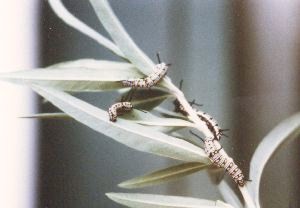 |
| African Monarch Larvae (Danaus chrysippus) |
The pinhead
sized eggs are collected from
the leaves where they are laid. The eggs are then cared for until they
hatch into caterpillars, which are fed host plant cuttings. When
the butterflies hatch from chrysalises, they are prepared as "papered"
specimens for sale to collectors. Some are kept back to
complete
the cycle in captivity.
Butterfly
farms can create employment in areas where opportunities and income are
scarce. It's one of the few industries where people living in and
around
natural area's can earn as much as they would in less environmentally
benign
ways. This good money entices farmers to preserve the existing forests,
or to re-grow trees and indigenous plants on degraded land.
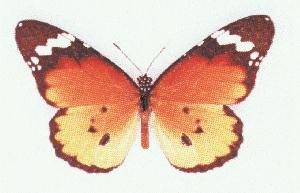 |
| African Monarch Adult (Danaus chrysippus) |
Butterfly
farming can be done at home with a
small investment in time, money and habitat. While it will not directly
reduce the illegal tree cutting common to the natural forests,
butterfly
farmers and other locals tended to view trees less as fodder for fires,
and more as a valuable standing resource. It's a participatory process
that gets everyone in a wooded area onboard to create community jobs
while
sustainably managing the natural forests.
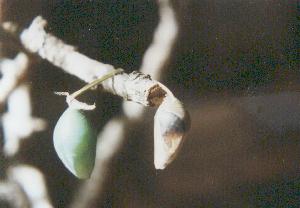 |
| Pearl Charaxes pupae (Charaxes varanes) |
The daily operation of an
established butterfly
farm has many components. Principally the entomological facet of
breeding
the butterflies, the horticultural duties of propagating the
appropriate
food plants and flowers, and inevitably the accounting and other
paperwork.
We will concentrate on the breeding process here. Although there are
many
methodologies in breeding butterflies, the following is one example of
a typical procedure.
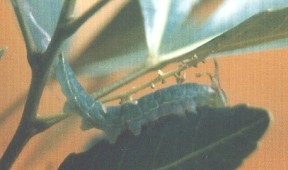 |
| Pearl Charaxes larvae (Charaxes varanes) |
A butterfly farm should be
managed in a way that
allows it to function symbiotically with the indigenous butterfly
populations.
An ideal habitat should be created by planting flowers and food plants
in abundance on the farm and in the vicinity. With the development of
these
plants, the farm should become a butterfly sanctuary of sorts by
providing
food and nectar in abundance.
 |
| Pearl Charaxes Butterfly (Charaxes varanes) Male |
Female
butterflies, caught from the wild or from
captive-bred stock, are released to fly freely within large enclosed
structures
that house the required host plants. As each butterfly species requires
a specific host plant for its survival, the farmer must anticipate the
species that he or she intends to breed by planting the necessary
plants
well in anticipation. A typical flight area measures about 25 sq.
meters
by 3 meters high, though there are no optimal dimensions. A fresh
female
can typically lay upwards of a hundred eggs. Some species will lay
their
eggs singly over many days. Others lay gregariously in a few sittings.
The ova
must be removed daily from the flight
areas and placed in a secure location where predators (ants, spiders,
wasps,
parasitic wasps, lizards, etc.) cannot get to them. The ova are placed
in small, parasite and predator proof plastic boxes.
 |
| White-barred Charaxes ( Charaxes brutus natalensis) Egg (Ovum) |
Searching for hundreds of tiny
butterfly eggs
in a large enclosure stuffed with foliage is not necessarily the
exercise
in tedium that it would seem.. The females of all species will lay only
on their respective host plant. Furthermore, each species will have a
preference
as to where the females lay their eggs. While one species will lay on
the
underside of old and dried leaves, another will lay only on the
tendrils
of the freshest new growth. With some experience, a person will quickly
discover the best places to look and make quick work of collecting the
ova.
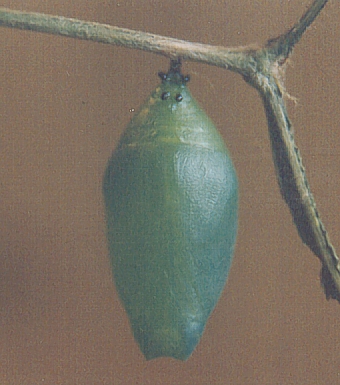 |
| White-barred Charaxes ( Charaxes brutus natalensis) Pupae |
The collected ovae must be
checked daily. The
first instar larvae should be removed with care and place on potted
food
plants which in turn are placed inside cages. During the larvae's first
two weeks, of first three instars, the caterpillars eat very little.
After
their third instar, the larvae become voracious. It is imperative that
the farmer have planted with months of anticipation sufficient food
plants
to feed the larvae in their latter stages. Because of the increased
volume
of food plant that each larva consumes, it becomes impractical to feed
them on potted plants. Rather, they must be fed on cuttings. Generally,
a fistful or two of the food plant will be cut for each cage. The stems
will be placed in a jar of water to preserve the foliage's freshness
for
twenty four hours. The larvae are then placed
on the cutting to feed as they wish.
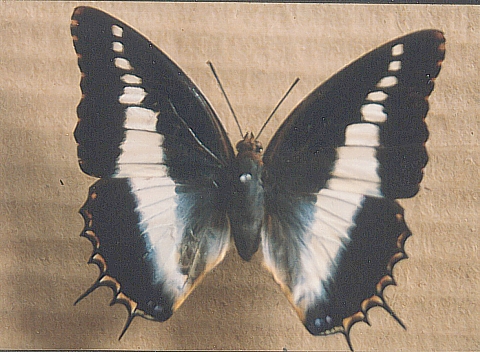 |
| White-barred Charaxes ( Charaxes brutus natalensis) Adult Butterfly |
The cages must be cleaned daily. This entails removing the stems of the devoured food plants from the previous day; removing the excrement from the floor of the cages; inserting new, freshly cut host plant; and returning the larvae on to their plants. The importance of cleanliness and diligence cannot be overly stressed. Failing this, even for one day, the larvae are likely to die from and assortment of diseases, viruses or starvation. When rearing just a few or thousands of larvae, cleanliness and attention to details are indisputably a key success factor for any butterfly breeding operation. Once completed their fifth and final instar, the larvae pupate. They may attach themselves as pupae on the ceiling of the cages or on the food plants. Care must be exercised while cleaning the cages lest they inadvertently discard pupae. Someone must check the cages and remove the pupae daily. As the pupae are usually of such short duration, only by collecting the pupae daily can a farmer be sure of the age of the pupae. Butterfly farming is by no means an easy endeavor. In the wild, butterflies may expect to enjoy a 3% survival rate between ova and adult. The 97% that perish along the way may be devoured by prey, succumb to virus or diseases or not be able subsist if the climatic conditions (drought, wind, temperatures, etc.) are not right. A successful farmer, by isolating the butterflies from Mother Nature's biological controls, may with luck raise the survival rate from 2% to as high as 90%.